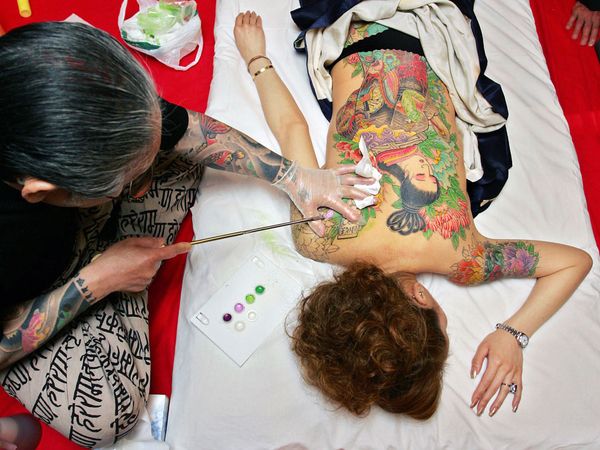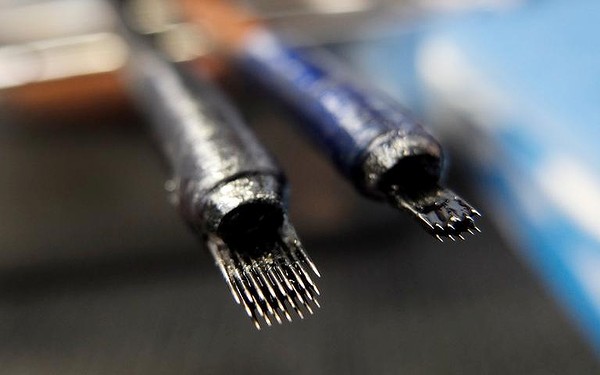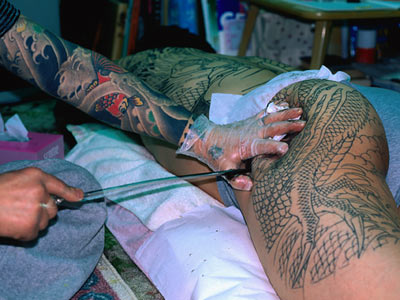While most people prefer to keep their tattooing experience as conventional, painless and sterile or sanitary as possible, some people like to live on the wild side. Obviously, this site and the authors do not recommend ever tattooing yourself with anything that has not been sterilized in an autoclave or that has been prepackaged and opened in your presence. Furthermore, tattooing when you are not trained in this art is not only dangerous, but puts you at risk for permanent defacement. Even more serious, using other people's needles, makeshift needles and rubbing foreign substances into your body can expose you to potentially fatal and incurable diseases and disorders that you will have to live with for the rest of your life. Still not scared? Dying your skin with unapproved dyes can cause major allergic reactions that can kill you slowly by suffocation or quickly via heart failure or outright poisoning or create infections that can require amputation in order to save your life. Always get tattooed by a trained, professional tattoo artist in an appropriately sterile and sanitary environment in order to keep yourself as safe and healthy as possible.
This article is for educational purposes only, and is not intended to be instructional material.
There are several methods of tattooing that do not involve using a modern tattoo gun. Some people enjoy using these methods for the experience, while others just do not have any other options. Most of these techniques have their origins in ancient tattoo methods. Maori Ta Moko tattoos are literally chiseled into the skin. In fact, Ta Mokomeans "to chisel" in the native language of this indigenous New Zealand tribe. A sharp object, traditionally a carved bone, is held against the skin and a hammer or blunt mallet is used to literally chisel away the skin and create an open, shallow wound into which ashes, dyes or colored clays are rubbed. Maori tribal tattoos are traditionally placed on the face, but many people prefer to have them custom designed for other parts of the body, particularly if they are going to have them inked in the traditional fashion.
Japanese tattooing, still performed by Japanese tattoo masters in that country, involves the use of a small instrument with sharp points shaped similarly to a rake. That instrument is used to scratch lines or pound dots into the skin, then an ink mixture is rubbed into the wounds. This procedure is highly ritualistic and it is considered a great honor to receive a tattoo in this manner from a Japanese tattoo master. These tattoos are frequently very large and require a lot of time and investment in order to complete.



Another frighteningly popular method of tattooing is called prison tattooing. This is because many people who have been incarcerated and have a great deal of time on their hands resort to tattooing themselves by whatever means are available largely to pass the time, as well as display their high pain tolerance, indicate gang membership or protection, and to show loved ones on the outside that they are thinking of them. Prison tattoos are probably the most dangerous form of alternative tattooing, and one study postulates that up to 60 percent of people who tattoo themselves in prison have exposed themselves to various forms of hepatitis by doing so. Prison tattoo designs are often scratched into the skin with a sharpened guitar string, pins, needles or even ink pens. The ink can be made from pen ink, melted checkers or anything else -- including dirt -- that will show up under the skin. Just as with ancient tribal tattoos, in order for these tattoos to remain clear on the skin, a person must either carve very deeply or repeatedly carve open the would and rub in additional ink. These tattoos are extremely dangerous and often fatal because the artists have no reliable means of sanitizing their equipment or keeping the tattoo clean and sterile while it heals. While many pass the needle under a lighter or douse it in rubbing alcohol, this is not sufficient to fully cleanse the equipment and leaves many germs and potential infections in tact.
Alternative tattoo methods can be an extremely memorable way to get a tattoo, but you must make sure that the artist is trained in the technique and that the equipment is sterile and the tattooing area sanitary. Also, if you will be using alternative dyes or tools, consult a doctor first to explore your options for testing out your reactions to these methods before you commit to an entire tattoo that potentially could create a serious infection or allergic issue.







